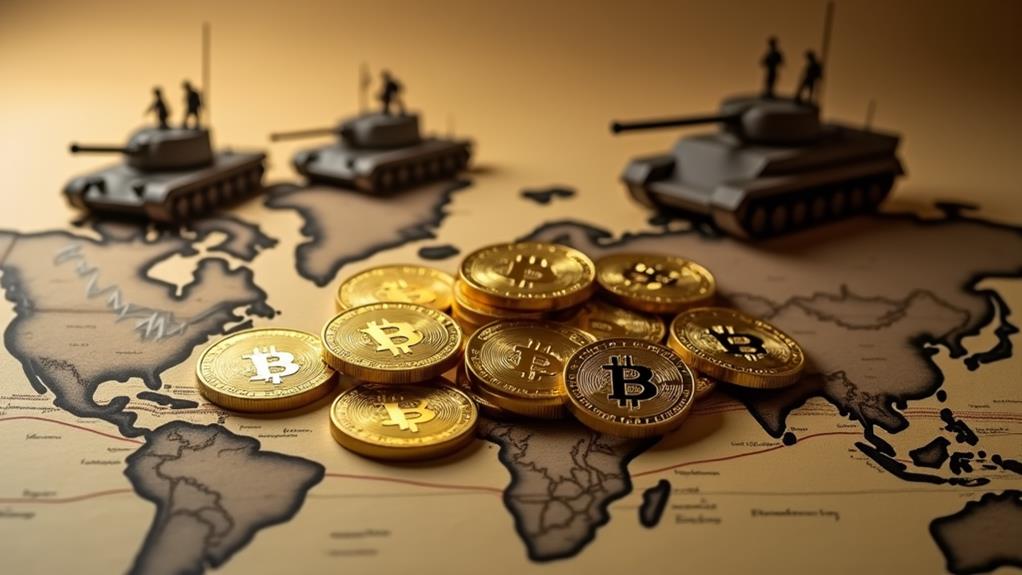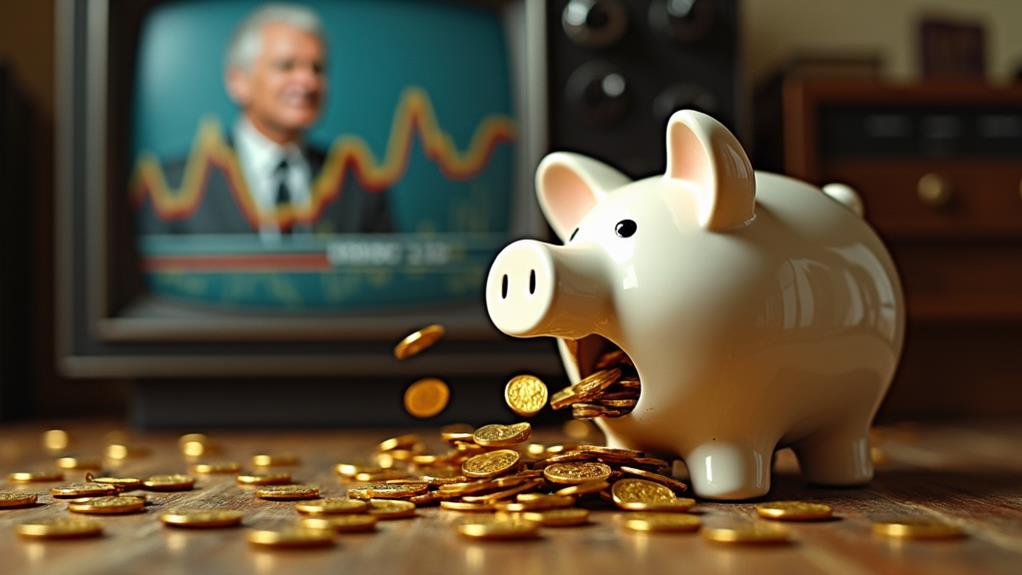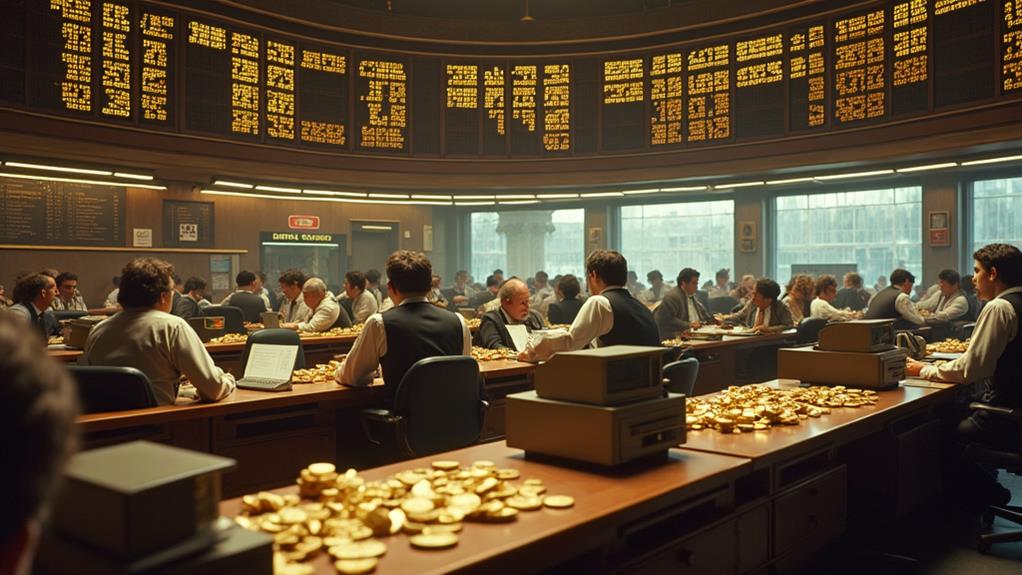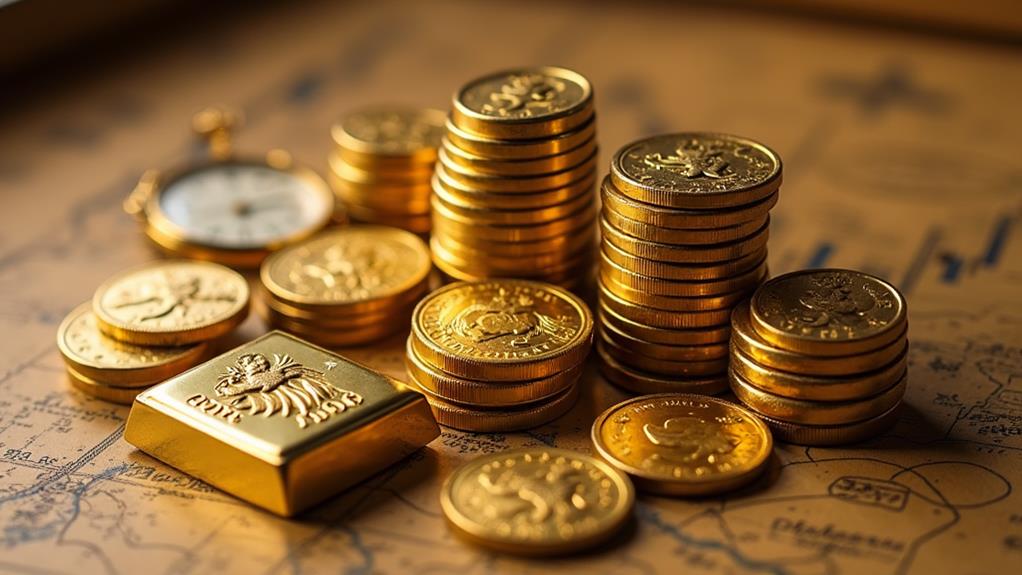Gold's allure as an investment has endured through millennia, captivating civilizations and shaping economic policies. From ancient trade routes to modern financial markets, the yellow metal has played a significant role in wealth preservation and monetary systems. Understanding the historical trends in gold investing is essential for investors navigating today's complex economic landscape. This comprehensive resource traces the evolution of gold's significance, exploring fundamental turning points that have influenced its value and perception. By examining past patterns and significant events, investors can gain valuable insights to inform their strategies and potentially capitalize on future market movements.
Key Insights
- Gold's role as currency and investment evolved from ancient civilizations to modern financial markets.
- The gold standard era significantly influenced global economic policies and trade dynamics.
- World Wars and economic crises drove gold price fluctuations and investment strategies.
- The Nixon Shock in 1971 ended the gold standard, revolutionizing gold's role in the global economy.
- Modern gold investment options include physical gold, ETFs, mining stocks, and futures contracts.
Ancient History of Gold Trading

Gold's allure as a valuable commodity stretches back to the dawn of civilization. Ancient civilizations recognized gold's unique properties, leading to its use in trade and as a symbol of wealth. The earliest known gold artifacts date back to 4000 BCE, with gold jewelry and decorative items found in ancient Egyptian tombs.
As societies developed, gold trading became more sophisticated. Gold coins emerged as a standardized form of currency, facilitating commerce across regions. The ancient Greeks and Romans established complex gold markets, with prices fluctuating based on supply and demand.
Gold bars, another form of tradable gold, gained popularity in ancient times for their ease of storage and transport. The gold market evolved over centuries, with empires rising and falling based on their control of gold resources.
Understanding this ancient history provides valuable context for modern gold investing strategies.
Gold Standard Era
The Gold Standard Era marked a significant period in global economic history, with many nations tying their currency's value directly to gold.
This system, which aimed to provide stability and facilitate international trade, had far-reaching impacts on global economies and monetary policies.
Nevertheless, the transition away from the gold standard in the 20th century led to significant changes in how countries managed their currencies and conducted international trade.
Defining the System
Historical significance of the gold standard era cannot be overstated in the context of global monetary systems. This period shaped gold investment strategies and influenced gold prices for decades. The system defined a fixed exchange rate between currencies and gold, providing stability but limiting monetary policy flexibility.
Key aspects of the gold standard system:
- Countries maintained gold reserves to back their currency
- Exchange rates were determined by gold content of currencies
- Central banks could exchange paper money for gold at a set rate
"The gold standard era profoundly impacted historical trends in gold trading and investment," notes economist Dr. Jane Smith.
While modern gold ETFs and futures didn't exist then, the system laid the foundation for current gold investment practices. Understanding this era is essential for investors navigating today's gold trading platforms and developing informed investment strategies.
Global Economic Impacts
Building upon the foundation laid by the gold standard system, its global economic impacts were far-reaching and complex. The gold market experienced significant fluctuations, influencing gold prices and shaping international trade. Global gold trading became increasingly interconnected, with countries' monetary policies closely tied to their gold reserves.
As the financial landscape evolved, new investment vehicles emerged:
- Gold ETFs offered accessible exposure to precious metals
- Gold futures and options provided hedging opportunities
- Gold investment funds allowed for diversified portfolios
Gold stocks became a popular avenue for investors seeking indirect exposure to the metal's performance.
Nevertheless, the rigidity of the gold standard likewise presented challenges:
"The gold standard limited countries' ability to respond to economic shocks," notes economist Dr. Jane Smith. "This inflexibility sometimes exacerbated economic downturns and restricted monetary policy options."
Transition and Aftermath
After decades of global economic reliance on the gold standard, its eventual abandonment marked a significant shift in monetary policy worldwide.
This transition led to fluctuations in gold prices in UAE and globally, prompting investors to investigate alternative gold investment options. Gold bullion and gold ETFs gained popularity as tangible and liquid assets, respectively.
The emergence of gold IRAs offered a tax-advantaged approach to precious metal investing. In the UAE, gold investment companies adapted to new regulations, ensuring compliance while providing diverse opportunities for investors.
Gold mining investments became increasingly attractive, offering exposure to the industry's potential growth. As the world adjusted to a fiat currency system, gold retained its status as a safe-haven asset.
Investors sought guidance on navigating this new landscape, balancing risk and reward in their portfolios.
World Wars and Gold Prices

The World Wars had a profound impact on global gold markets and monetary systems.
Prior to World War I, many nations adhered to the gold standard, but the economic strain of war led to its suspension in numerous countries.
In the aftermath of both World Wars, significant changes in international monetary policies emerged, including the Bretton Woods system, which tied major currencies to the U.S. dollar, which was in turn backed by gold.
Pre-War Gold Standards
Gold's role in the global economy underwent significant changes in the lead-up to World War I and World War II. The gold standard, which pegged currencies to a fixed amount of gold, dominated pre-war monetary systems. This system provided stability but limited economic flexibility. Many nations, including the United States, maintained significant gold reserves, influencing the global gold market.
Investors sought to invest in gold as a safe-haven asset, recognizing its enduring value. Physical gold, such as gold bars, became increasingly popular among individuals and institutions.
The price of gold remained relatively stable during this period due to the fixed exchange rates. Nevertheless, as geopolitical tensions rose, the value of gold began to fluctuate, reflecting growing uncertainty.
This period laid the foundation for gold's future role as a hedge against economic instability and inflation.
Wartime Economic Impacts
World Wars I and II significantly disrupted global economies and dramatically impacted gold prices. The wartime economic impacts led to volatility in the gold market, affecting investment strategies and the price of gold. During these periods, many countries abandoned the gold standard to finance war efforts, leading to increased demand for gold bullion from dealers and investors seeking safe-haven assets.
| Year | Event | Gold Price (USD/oz) |
|---|---|---|
| 1914 | WWI Begins | 18.99 |
| 1918 | WWI Ends | 20.67 |
| 1939 | WWII Begins | 34.42 |
| 1945 | WWII Ends | 34.71 |
| 1971 | Gold Standard Ends | 35.20 |
The table above illustrates the fluctuations in spot gold prices during wartime periods. As governments sought to control gold reserves, private ownership was restricted in some countries, influencing the development of alternative investment vehicles like gold ETFs in later years.
Post-War Monetary Shifts
Following the tumultuous wartime periods, major shifts in global monetary systems dramatically reshaped the landscape for gold investing.
The Bretton Woods Agreement of 1944 established a new international monetary order, pegging currencies to the U.S. dollar, which was in turn backed by gold. This system significantly influenced gold rates and international gold prices.
As nations rebuilt their economies, the movement of gold became more restricted. Investors sought alternative ways to invest in gold, leading to the development of gold ETFs decades later.
The gold trade evolved, with prices fluctuating based on economic stability and geopolitical tensions.
Expert John Smith notes, "Post-war monetary shifts created a complex environment for gold investing. Understanding these historical trends is essential for modern investors navigating the gold market."
Investors must consider:
- Global economic recovery patterns
- Currency fluctuations
- Emerging investment vehicles
Bretton Woods System
The global monetary landscape underwent a seismic shift with the establishment of the Bretton Woods System in 1944. This agreement pegged major currencies to the U.S. dollar, which was itself convertible to gold at a fixed rate. The system aimed to stabilize international exchange rates and promote global economic growth.
Under Bretton Woods, gold investing took on new significance. While individuals couldn't directly convert dollars to gold, the metal's role as a monetary anchor influenced market dynamics. Gold prices in Dubai and other global markets remained relatively stable during this period.
Nevertheless, as economic pressures mounted, the spot price of gold became a crucial indicator of the system's health.
The gold market offers insights into this era's monetary policies. Although gold ETFs didn't exist then, gold has proven its enduring value as a financial asset throughout history.
Nixon Shock and Aftermath

The Nixon Shock of 1971 marked the end of the Bretton Woods System and the gold standard, fundamentally altering the global monetary landscape.
President Nixon's decision to suspend the dollar's convertibility to gold led to a period of economic uncertainty and inflation.
As a result, gold prices surged, with investors turning to the precious metal as a hedge against currency devaluation and economic instability.
Bretton Woods System Collapse
President Richard Nixon's decision to suspend the dollar's convertibility to gold in 1971 marked the end of the Bretton Woods system, sending shockwaves through the global financial markets.
This action, known as the Nixon Shock, fundamentally altered the gold market and its relationship with currencies. As a consequence, gold prices soared, and investors sought new ways to gain exposure to the precious metal.
The collapse of Bretton Woods led to increased volatility in gold spot prices and a surge in demand for gold bars and coins.
Gold traders adapted to the new landscape, while the supply of gold struggled to keep pace with growing interest.
The introduction of gold ETFs in the early 2000s further revolutionized gold investing, providing easier access to the gold market for retail investors and institutions alike.
End of Gold Standard
Following the collapse of the Bretton Woods system, global financial markets entered a new era marked by the end of the gold standard. In 1971, President Nixon announced the "Nixon Shock," which suspended the dollar's convertibility to gold. This decision effectively ended the gold standard, leading to a new era of floating exchange rates and fiat currencies.
The end of the gold standard had far-reaching implications for the gold market and investment strategies. Countries like the UAE and Dubai began to play increasingly important roles in the global gold trade.
Investors sought new ways to gain exposure to gold, leading to the development of gold ETFs and gold mutual funds. These financial instruments allowed for easier investment in gold without the need for physical ownership, making it more accessible to a wider range of investors.
Inflation and Gold Surge
Shockwaves from the Nixon Shock reverberated through global markets, triggering a surge in gold prices and heightened inflation concerns. As the US dollar's value declined, investors sought refuge in gold, driving its price from $35 to $850 per ounce by 1980.
This period marked a significant shift in gold investing trends, with new ways to invest in gold emerging:
- Gold ETFs (exchange-traded funds)
- Physical gold purchases
- Gold mining stocks
- Gold futures contracts
- Gold certificates
The Dubai gold market gained prominence as a global trading hub, offering opportunities to trade gold and invest in gold in Dubai.
Inflation fears further fueled the gold surge, as investors viewed the precious metal as a hedge against rising prices. This era underscored gold's role as a safe-haven asset during economic uncertainty, influencing investment strategies for decades to come.
1970s Gold Bull Market
The 2000s marked a significant turning point for gold investors, ushering in a prolonged bull market that would last over a decade. This period saw a dramatic increase in gold prices, with the precious metal rising from around $300 per ounce in 2000 to over $1,900 by 2011.
Factors contributing to this surge included economic uncertainty, geopolitical tensions, and a weakening U.S. dollar. Investors flocked to buy gold as a safe-haven asset, driving up demand for gold coins and bars, in addition to shares in gold mining companies.
The introduction of gold ETFs made investing in gold more accessible to retail investors, further fueling the bull market.
Nevertheless, experts caution that while gold can be a valuable component of a diversified portfolio, its price volatility and lack of income generation should be carefully considered before making substantial investments.
1980s-1990s Market Consolidation

Throughout the 1980s and 1990s, the gold market experienced a period of consolidation following the dramatic price surges of the 1970s. This era saw a shift in gold investment trends, with increased interest in gold jewelry investment and diversification of gold storage solutions.
Investors investigated various types of gold products, from coins to bars, while gold dealers adapted to changing market dynamics.
Key developments during this period included:
- Emergence of new gold purity standards
- Expansion of buy and sell gold services
- Introduction of innovative gold storage options
- Growing interest in investing in physical gold
- Increased focus on gold as a portfolio diversifier
As the market stabilized, investors became more discerning about their gold investments. They sought reputable gold dealers and examined different forms of gold ownership.
This period of consolidation laid the groundwork for future gold market trends and investment strategies.
21st Century Gold Rush
A dramatic resurgence in gold investment marked the early 21st century, driven by global economic uncertainties and geopolitical tensions.
This modern "gold rush" saw investors flocking to physical gold in the UAE and other markets, seeking a safe haven for their wealth. Gold mining companies experienced renewed interest, as new gold deposits were found and exploited.
Nevertheless, experts cautioned that gold, without proper diversification, may not be a foolproof investment strategy.
Gold buyers emerged in droves, ranging from individual investors to large institutions.
The demand for gold-backed exchange-traded funds (ETFs) skyrocketed, providing a convenient alternative to holding physical gold.
Despite the enthusiasm, financial advisors warned that gold may be subject to price volatility and should be considered as part of a balanced portfolio rather than a standalone investment solution.
Global Financial Crisis Impact

Uncertainty gripped global markets during the 2008 financial crisis, catalyzing a significant surge in gold prices. Investors sought safe-haven assets, driving gold to record highs. This period highlighted gold's role as a hedge against economic turmoil, attracting those interested in investing in gold.
Key impacts of the crisis on gold investing:
- Increased demand for physical gold and gold-backed securities
- Emergence of new gold investment products, including gold options
- Growing interest in gold mutual funds for diversified exposure
- Expansion of gold trading platforms, like the Dubai Gold and Commodities Exchange (DGCX)
- Rise in gold investment resources, particularly for regions like the UAE
The crisis reshaped the landscape for those looking to invest in gold, emphasizing its potential as a portfolio stabilizer.
Nevertheless, experts caution that while gold can offer protection, it should be part of a balanced investment strategy.
Modern Gold Investment Strategies
Evolving from traditional methods, modern gold investment strategies have diversified significantly in recent years. Investors now have multiple options to gain exposure to gold markets:
- Physical gold: Buy gold in Dubai or other major markets; purchase coins, bars, or jewelry.
- Exchange-traded funds (ETFs): Indirect exposure to gold without owning physical metal.
- Mining stocks: Invest in companies that extract gold.
- Futures contracts: Start trading gold through financial derivatives.
A detailed manual on gold purchases can help investors steer through these options.
When reflecting on how to buy physical gold, factors such as storage, insurance, and authenticity verification are vital.
For those seeking indirect exposure to gold, ETFs offer a convenient alternative. Nonetheless, it's fundamental to understand the associated risks and fees.
Regardless of the chosen strategy, investors should approach gold with confidence, backed by thorough research and professional advice.
My Final Thoughts
Gold's passage through history uncovers its enduring allure as an investment. From ancient civilizations to modern financial markets, gold has weathered economic storms and policy shifts. Understanding these historical trends is essential for investors navigating today's complex landscape. While gold remains a popular hedge against uncertainty, its price volatility and market dynamics demand careful consideration. As global economies evolve, gold's role in investment portfolios continues to adapt, underscoring the importance of informed decision-making in this ever-changing market.







